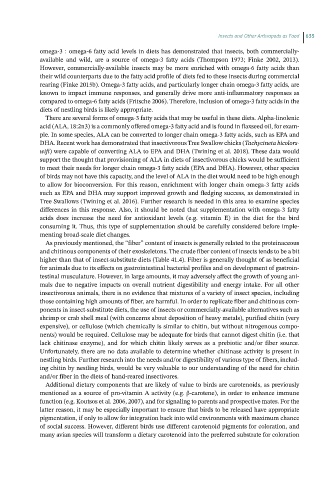Page 634 - Hand rearing birds second
P. 634
Insects and Other Arthropods as Food 635
omega-3 : omega-6 fatty acid levels in diets has demonstrated that insects, both commercially-
available and wild, are a source of omega-3 fatty acids (Thompson 1973; Finke 2002, 2013).
However, commercially-available insects may be more enriched with omega-6 fatty acids than
their wild counterparts due to the fatty acid profile of diets fed to these insects during commercial
rearing (Finke 2015b). Omega-3 fatty acids, and particularly longer chain omega-3 fatty acids, are
known to impact immune responses, and generally drive more anti-inflammatory responses as
compared to omega-6 fatty acids (Fritsche 2006). Therefore, inclusion of omega-3 fatty acids in the
diets of nestling birds is likely appropriate.
There are several forms of omega-3 fatty acids that may be useful in these diets. Alpha-linolenic
acid (ALA, 18:2n3) is a commonly offered omega-3 fatty acid and is found in flaxseed oil, for exam-
ple. In some species, ALA can be converted to longer chain omega-3 fatty acids, such as EPA and
DHA. Recent work has demonstrated that insectivorous Tree Swallow chicks (Tachycineta bicolors-
wift) were capable of converting ALA to EPA and DHA (Twining et al. 2018). These data would
support the thought that provisioning of ALA in diets of insectivorous chicks would be sufficient
to meet their needs for longer chain omega-3 fatty acids (EPA and DHA). However, other species
of birds may not have this capacity, and the level of ALA in the diet would need to be high enough
to allow for bioconversion. For this reason, enrichment with longer chain omega-3 fatty acids
such as EPA and DHA may support improved growth and fledging success, as demonstrated in
Tree Swallows (Twining et al. 2016). Further research is needed in this area to examine species
differences in this response. Also, it should be noted that supplementation with omega-3 fatty
acids does increase the need for antioxidant levels (e.g. vitamin E) in the diet for the bird
consuming it. Thus, this type of supplementation should be carefully considered before imple-
menting broad-scale diet changes.
As previously mentioned, the “fiber” content of insects is generally related to the proteinaceous
and chitinous components of their exoskeletons. The crude fiber content of insects tends to be a bit
higher than that of insect-substitute diets (Table 41.4). Fiber is generally thought of as beneficial
for animals due to its effects on gastrointestinal bacterial profiles and on development of gastroin-
testinal musculature. However, in large amounts, it may adversely affect the growth of young ani-
mals due to negative impacts on overall nutrient digestibility and energy intake. For all other
insectivorous animals, there is no evidence that mixtures of a variety of insect species, including
those containing high amounts of fiber, are harmful. In order to replicate fiber and chitinous com-
ponents in insect-substitute diets, the use of insects or commercially-available alternatives such as
shrimp or crab shell meal (with concerns about deposition of heavy metals), purified chitin (very
expensive), or cellulose (which chemically is similar to chitin, but without nitrogenous compo-
nents) would be required. Cellulose may be adequate for birds that cannot digest chitin (i.e. that
lack chitinase enzyme), and for which chitin likely serves as a prebiotic and/or fiber source.
Unfortunately, there are no data available to determine whether chitinase activity is present in
nestling birds. Further research into the needs and/or digestibility of various type of fibers, includ-
ing chitin by nestling birds, would be very valuable to our understanding of the need for chitin
and/or fiber in the diets of hand-reared insectivores.
Additional dietary components that are likely of value to birds are carotenoids, as previously
mentioned as a source of pro-vitamin A activity (e.g. β-carotene), in order to enhance immune
function (e.g. Koutsos et al. 2006, 2007), and for signaling to parents and prospective mates. For the
latter reason, it may be especially important to ensure that birds to be released have appropriate
pigmentation, if only to allow for integration back into wild environments with maximum chance
of social success. However, different birds use different carotenoid pigments for coloration, and
many avian species will transform a dietary carotenoid into the preferred substrate for coloration

